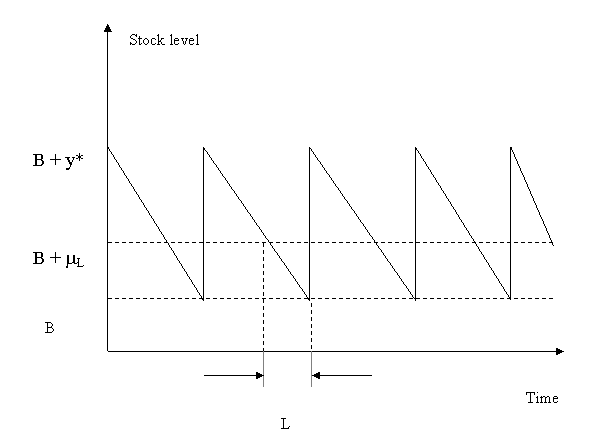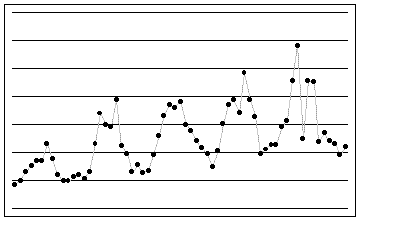"Efficiency increase of transporting and sales system on an enterprise" *
In transition of its own structure or the country as a whole each enterprise faces with necessity of the economic structure perfection. Thus two objects are purposed usually. They are the adaptation to new external conditions and efficiency increase of usage of a fixed capital. One of these problems is connected with effective inventory management. Unjustified inventory level can lead to financial actives freeze [2]. Besides it is connected with high storage costs and risk of moral and physical obsolescence [4,5]. Also there exists risk of validity termination. On the contrary, low inventory level can lead to the situation when the enterprise will be not ready to satisfy available demand and will lose part of the clients [1]. Such loss could essentially affect a financial position. Therefore, there is a necessity of efficient control stocks.
At present the Ukrainian enterprises reconsider existing and introduce new information control systems. The prevalent at the enterprises situation determines necessity of formation of new methodical bases and development of practical recommendations on construction of inventory control systems by stocks. Inventory management processes are the part of Business Intelligence system. Therefore their efficiency is characterized by such important criterion, as value of the expenses formed in process of inventory control. Traditional parameters, such as stock level, stock turnover are used independently. So they can not ambiguously determine a degree level of effectiveness increase of a inventory system as they are a part of the general criterion, the expenses.
Now solving of these problems is impossible without modern computer application [4]. As the practice shows, the automated control systems are expensive. Not every enterprise presumes to introduce them in practice [10]. Besides the methods of estimation and stock management are imperfect and need completion.
That’s why the urgency of a master’s work theme is determined by studying of problems, connected with formation of inventory control system on stocks with seasonal demand for production. There will be realized (Q, r) – stochastic inventory model in this automated system. (Q,r) –model is system in which the request of size Q is placed each time when the stock level falls to r.
The purpose of research is reduction of logistical costs at the enterprises due to increase of forecast precision, decrease of value of excessive stocks, improvement of accepted decisions quality.
Hence the following objectives were formulated and will be solved:
- research of a inventory control problem in warehouses with the brewing production and study of existing inventory management methods;
- a substantiation of usage of dynamic model;
- development of the automated inventory system on the basis of stochastic inventory control model with the continuous control of a stock level;
- carrying out of experimental researches of the offered system and analytical comparison with existing management models.
The subbject of research is the set of methods, systems
and concepts of inventory control at small business in brewing industry.
As object of research were chosen enterprise stocks, their turnover, storage and sale.
As research yet has not been completed, it is impossible to tell what is the scientific value of final work. However creation of the automated control system is supposed on the basis of available models and methodologies. The given automated system will allow the enterprises to minimize introduction costs. Besides on the basis of available statistics for the previous periods, the system will allow to increase efficiency of orders and stocks turnover.
The problems connected with inventory keeping were developed by many scientists. Let's consider some from them.
The classical model of the economic order quantity is the most elementary model for definition of the optimal order quantity. The basic assumptions are:
- demand is continuous and determined, its intensity is equal λ;
- time of delivery τ is constant and does not depend from the order quantity;
- optimal strategy of functioning is determined from a condition of minimum of average total costs.
Hence, the order quantity will be always identical, and replenish level at the moment of reorder receipt will be the same. As demand is not chance and time of delivery is constant, ithere is no deficiency in system [3,6].
Total Costs Unit (TCU) include fixed costs connected with cost of placement of order (K) and storage costs (h) and value of the goods (C).
Storage costs for order interval T are defined under the formula (2.1):

Where s – stock on hand by the moment of delivery;
Q - the order quantity;
T - time between two orders. It is defined under the formula (2.2):

Total Costs per Unit time are defined under the formula (2.3):

We shall find a minimum of function TCU (Q):

whence

where Q* - the optimal prder quantity.
The formula (2.5) gives the answer to a question, how many to order, the answer to a question when it is necessary to place the order gives the point of the replenish (i.e. it is stock level at the moment of application placement), determined by the formula (2.6):

where m - maximal integer, smaller or equal τ/T.
Each time when the stock on hand decrease to replenish level r the order of Q units is placed. This strategy is shown in picture 2.1.

In the considered system updating of stock level occurred instantly [7], as receipt of order at the rate Q. But receipt can occur not instantly, with certain intensity μ. Thus intensity of receipt production is μ units in year, and intensity of demand for this production - λ units per year.
Then, in view of the given notations, the formula (2.3) can be rewritten as follows:

The optimal order quantity and replenish point are defined under formulas (2.8) and (2.9).


In most cases value Q* is rather great, and consequently it is possible to consider demand as variate and to approximate Q* to the nearest integer. But in a case of slow sellers this assumption is not valid. In this case it is considered, that requirements are discrete, and Q* - an integer. Then the optimal order quantity is defined proceeding from a condition (2.10):

Optimal value Q* is Q=1 or, for Q> 1, the maximal Q which satisfies a condition (2.11):

From here, Q* is the maximal positive integer Q for which the ratio (2.12) is carried out:

Let t s - time between replacement of order, and  - time from the moment of placement of the order till the moment of delivery of the next order, determined under the formula (2.13):
- time from the moment of placement of the order till the moment of delivery of the next order, determined under the formula (2.13):

Then replenish point r is defined as the highest possible integer, smaller or equal  (2.14).
(2.14).
The given model is based on the same assumptions, as classical inventory model. However, it is supposed, that since the previous periods there can be left an unexpended stock. Therefore the model from single-factor becomes two-factor: it is required to find such replenish level and the rest since the previous period at which general function of average costs would be minimal [8]:

in constraints

The optimal replenish level is defined in model by algorithms of dynamic programming. And, the algorithm is labour-consuming enough.
All models which have been considered before are systems with a constant demand intensity. Such situation in practice meets seldom. Therefore inventory models were developed on the basis of random demand.
We shall consider the determined model of the economic order quantity for random demand [9]. Thus the approximated method which assumes existence of a constant buffer stock during all scheduled period is used. The size of a reserve is established so that the probability of an exhaustion of a stock during the period of order fulfillment (an interval between the moment of order placement and its delivery) did not exceed beforehand set quantity. Let's enter the following designations.
- L - term of order fulfillment, i.e. time from the moment of order placement to its delivery;
- X1-a random variable representing size of demand during term of order fulfillment;
- μ - average size of demand during term of order fulfillment,
- σ - standard deviation of size of demand during term of order fulfillment;
- β - replenish level;
- α - the greatest possible value of exhaustion probability during term of order fulfillment.
The basic assumption in model is that the size of demand Х1 during term of order fulfillment L is normally distributed random variable with average μ1 and a standard deviation σ1, i.e. has distribution N (μ1, σ1)
In figure 2.2 the dependence between the replenish level β and parameters of the determined model of the economic order quantity which includes term of performance of order L, average size of demand &mu is shown.

Probabilistic constraint which defines replenish level β, looks like:

By definition a random variable

is normalized normally distributed random variable, i.e. has distribution N (0, 1). Hence,

At the given stage authors [3] had been entered random variable α, which is defined from the table of standard normal distribution, thus that:

Hence, the replenish level should satisfy to an inequality

The size of demand during term of order fulfillment L is usually described by density of probabilities distribution, related to a time unit (for example, to day or week) from which it is possible to define demand distribution during period L. In particular, if demand for a time unit is normally distributed random variable with average D and a standard deviation σ, the general demand during term of order fulfillment L will have distribution N (μL, σL), where μL=DL and 
The formula for σ L is received from constraint that L is an integer (or it is approximated to an integer).
There are two basic inventory control systems: system with the constant control and system with periodic checks [3].
In system with periodic checks reserve estimation is made periodically (once a day, week, month), and depending on a level of stock on hand the order is placed.
Also inventory control system can be based on inventory model with the constant control of a stock level, i.e. system in which each time when the stock level falls to r, the order in amount of Q units is placed.
At the determined and random demand dynamics of stock is shown at figures 3.1 and 3.2 accordingly.


In this master’s work the model with the continuous control was chosen. It had been offered by Hedley and Whittin [3]. Besides this model was corrected on differed demand. Also we modified given model by leading into it constraints of transport costs and differential discounts depending on order quantity.
Last condition is the extremely important for any enterprise as buying of the bigger quantity of goods under the smaller price helps save money. In some cases decrease appears to be essential.
As real processes are too complex three assumptions are accepted in considered model.
- Unsatisfied demand accumulated during term of order fulfillment.
- It assumes no more than one outstanding order.
- Distribution of demand during term of order fulfillment is stationary in time.
For definition of TCU function we shall enter the following designations.
- f (x) – frequency distribution of demand х during term of order fulfillment
- D - expected value of demand per time unit
- h – storage costs (on a unit of production per a time unit)
- р - losses from a backlog demand (on a unit of production per a time unit)
- K - cost of placement of the order.
- E (x) - function of transportation expenses depending on demand size.
- G (y) - function order cost.
The total cost function is used as criterion of an optimality. It consists of the following items:
- Cost of placement of order. The approximated number of orders per time unit is equal D/y so cost of placement of order is equal KD/y.
- Expected storage costs. The average level of a stock is equal

Hence, expected storage costs per time unit are equal hI. - Transportation cost for satisfaction of consumers demand. Function has graded view as with growth of order quantity cost of its transportation grows:

- Expected losses connected with a backlog demand.
Deficiency arises at х> R. Hence, expected deficiency per time unit is equal:

- Cost of the order will look as follows:

Total Cost function per time Unit (TCU) has the following kind.

Optimal quantities у* and R* are defined from the equations submitted below.

For finding y* and R, we use the numerical algorithm suggested by Hadley and Whittin[3]. But our algorithm is slightly modified.
Step 0. We Find y (j) as  , R0=0. We pass to i-step.
, R0=0. We pass to i-step.
Step i. For each y (j) , we find R (j) on i-step.  , i=i+1.
, i=i+1.
Criterion of exit: 
It is necessary to take into consideration features of the enterprises for which the system is developed. As beer is the seasonal goods it should be somehow taken into account. In master’s work the following approach has been developed.
On the basis of the statistic data there are allocated so-called "peaks" of demand, i.e. intervals with minimal and maximal values. Then all the data for a year are broken into four sections concerning a minimum and a maximum. Then we form four density functions on a basis of Lagrange interpolation formula. And then depending on to what part of year day is related, this or that function is used.
The figure 3.3 shows an example of density function selection. As an example the maximal peak has been chosen. The maximal peak correspond to warm months.

The algorithm of work of the automated control system looks as follows:

The given system cannot be used in practice as only one product is considered in it. Real inventory control systems should be multinomenclate.
In this paper there was (Q, r) inventory control system of the goods with seasonal demand. The developed system is based on the approached description of its expected parameters.
For accuracy increase of system the new parameters are entered. Among them are the differential discount for goods volume, a suspended demand of the previous period and transport expenses. Besides for system effectiveness increase there entered a forecasting algorithm on basis of fragmentation of density function into small sections with expressed seasonal movements.
For use of the considered system in practice it is necessary to take into consideration constraints arising during solving of realistic multinomenclate problems.
- Inventory control. Why inventory control? //Counselors to America's small business. - www.ct-clic.com/business/score/inventory0602.pdf
- Черненко М. Проблемы управления украинскими предприятиями. // Корпоративные системы, 2002, № 4. -www.cs.comizdat.com
- Хедли Дж., Уайтин Т. Анализ систем управления запасами. – М., «Наука», 1969. – 511 с.
- Хруцкий Е. А. Оптимизация хозяйственных связей и материальных запасов (Вопросы методологии). – М.: Экономика, 1997. – 263 с.
- Сергей Семенов. “Что там у него в карманцах?” // Бизнес, №18 (537), 05.05. 2003. -www.business.ua
- Хэнссмен Ф. Применение математических методов в управлении производством и запасами. – М.: «Прогресс», 1966.
- atv-emmm.narod.ru/logist/loglecture.htm
- iasa.org.ua/iso
- Вероятностные модели управления запасами
- Черкашина Т. Інформаційні системи управління складами у малому бізнесі.//Проблеми впровадження інформаційних систем і технологій в економіці та бізнесі. Збірник матеріалів VII наукової студентської конференції, 27-29 листопада 2006. - К2006: с.146-148.
*While writing of the given abstract, master’s thesis haven’t been completed yet. Final completion will be at January, 2008. The full text of work and all materials on a theme can be received from the author or her leader after the specified date.